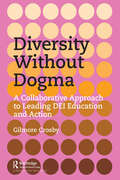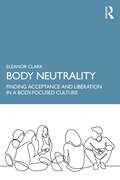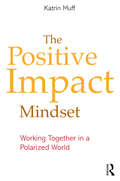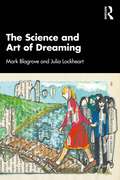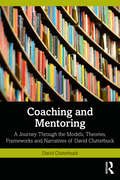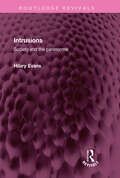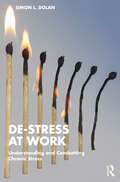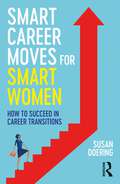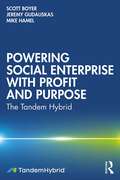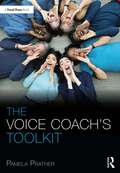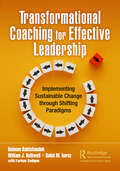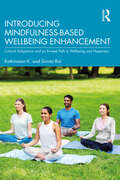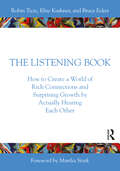- Table View
- List View
Diversity Without Dogma: A Collaborative Approach to Leading DEI Education and Action
by Gilmore CrosbySocial Scientist Kurt Lewin said, "No research without action, and no action without research." Too much of the current DEI (diversity, equity, and inclusion) approach is insight-based instead of action-based. Even though institutional racism is identified as the root problem, the change effort is focused on looking inward for bias instead of taking action to eliminate institutional racism and other isms. A Lewinian approach, in contrast, is balanced. What people think is important, but no more important than what people do. If you bring people together to change things, this will change what people think! We don’t need therapy nearly as much as we need action based on dialogue! Instead of spending your energy soul-searching for evidence in your thoughts and behaviors that you have unconscious biases, this book helps put your energy into doing something practical about racism. To get there, this book uses Lewin’s social science to build a framework for sorting through the many approaches to and positions held on race, racism, diversity, and related topics. While the framework is and must be applicable to any prejudice, systemic or individual, the bulk of this exploration is focused on racism, which to a large degree has become the primary social justice focus of our times. Painfully aware that conversations about race can easily deteriorate into polarization, the author lays a path toward finding common ground.
Body Neutrality: Finding Acceptance and Liberation in a Body-Focused Culture
by Eleanor ClarkThis practical, accessible book teaches readers how to practice healthy body image habits and let go of an emphasis on body image through research, activities, and personal stories. Body neutrality is a body image approach focused on finding acceptance and liberation from the body-focused culture in which we live. Body neutrality is a shift toward seeing our bodies as a vessel of who we are rather than as who we are. This guide is organized into thirteen chapters, each outlining a different concept of body neutrality ranging from comparison and identity to mindfulness and gratitude, inviting participation from the reader through end-of-chapter activities. For anyone aiming to release the enslaving emphasis placed on appearance in a world where body obsession has become inappropriately “normal,” this book will provide insight and practical guidance toward freedom. Body Neutrality is for anyone struggling with self-esteem and body image issues who aims for acceptance and liberation.
Body Neutrality: Finding Acceptance and Liberation in a Body-Focused Culture
by Eleanor ClarkThis practical, accessible book teaches readers how to practice healthy body image habits and let go of an emphasis on body image through research, activities, and personal stories. Body neutrality is a body image approach focused on finding acceptance and liberation from the body-focused culture in which we live. Body neutrality is a shift toward seeing our bodies as a vessel of who we are rather than as who we are. This guide is organized into thirteen chapters, each outlining a different concept of body neutrality ranging from comparison and identity to mindfulness and gratitude, inviting participation from the reader through end-of-chapter activities. For anyone aiming to release the enslaving emphasis placed on appearance in a world where body obsession has become inappropriately “normal,” this book will provide insight and practical guidance toward freedom. Body Neutrality is for anyone struggling with self-esteem and body image issues who aims for acceptance and liberation.
The Positive Impact Mindset: Working Together in a Polarized World
by Katrin MuffWe are facing a new and urgent challenge when collaborating across organizations, and with broader stakeholder groups: how to overcome polarization. It has never been harder to find a common vision, when opinions are often considered as facts. This book empowers changemakers and business leaders to understand how successful organizations in the 21st century require leaders to become fluent in collaborating outside of traditional business boundaries. Such collaboration often involves working with parties that hold very different values, opinions and priorities, and working with them requires new skills. Building on the book Five Superpowers for Co-Creators, Katrin Muff presents a number of real-world examples that demonstrate how organizations have successfully managed to address these challenges. Examples of such unlikely but successful cross-sector collaboration include a project addressing plastic waste in Switzerland, and two European city government projects that reached out beyond organizational boundaries. The book features many stories of trial and error in overcoming the societal polarization gap. From all these insights emerges clear guidance as to how leaders and organizations can transform to new ‘outside-in’ mindsets to overcome polarization and develop a Positive Impact Mindset. The book is ideal for use by facilitators, educators, business and political leaders, and consultants, who are seeking solutions within an often polarized world to achieve sustainable change and a positive impact.
The Positive Impact Mindset: Working Together in a Polarized World
by Katrin MuffWe are facing a new and urgent challenge when collaborating across organizations, and with broader stakeholder groups: how to overcome polarization. It has never been harder to find a common vision, when opinions are often considered as facts. This book empowers changemakers and business leaders to understand how successful organizations in the 21st century require leaders to become fluent in collaborating outside of traditional business boundaries. Such collaboration often involves working with parties that hold very different values, opinions and priorities, and working with them requires new skills. Building on the book Five Superpowers for Co-Creators, Katrin Muff presents a number of real-world examples that demonstrate how organizations have successfully managed to address these challenges. Examples of such unlikely but successful cross-sector collaboration include a project addressing plastic waste in Switzerland, and two European city government projects that reached out beyond organizational boundaries. The book features many stories of trial and error in overcoming the societal polarization gap. From all these insights emerges clear guidance as to how leaders and organizations can transform to new ‘outside-in’ mindsets to overcome polarization and develop a Positive Impact Mindset. The book is ideal for use by facilitators, educators, business and political leaders, and consultants, who are seeking solutions within an often polarized world to achieve sustainable change and a positive impact.
The Science and Art of Dreaming
by Mark Blagrove Julia LockheartThe Science and Art of Dreaming is an innovative text that reviews the neuroscience and psychology of how dreams are produced, how they are recalled and their relationship to waking life events and concerns of the dreamer. Featuring beautiful original artwork based on dream representations, the book delves deeply into what happens when we dream, the works of art we produce when asleep and the relevance of dreaming to science, art and film. The book examines the biological, psychological and social causes of dreaming, and includes recent advances in the study of nightmares and lucid dreaming. It shows how sleep can process memories and that dreams may reflect these processes, but also that dreams can elicit self-disclosure and empathy when they are shared after waking. The playfulness, originality and metaphorical content of dreams also link them to art, and especially to the cultural movement that has most valued dreams – Surrealism. The book details the history of scientific research into dreams, including a re-reading of the two dreams of Freud’s patient, the feminist hero Dora, and also the history of Surrealism and of films that draw on dreams and dream-like processes. Each chapter starts with a dream narrative and accompanying painting of the dream to highlight aspects of each of the chapter themes. This highly engaging book will be relevant to researchers, students and lecturers in the fields of psychology, neuroscience, psychoanalysis, consciousness and social evolution. It will also be of value within the study and practice of visual art, design and film, and will be of interest to the general reader and anyone who holds a personal interest in their own dreams.
The Science and Art of Dreaming
by Mark Blagrove Julia LockheartThe Science and Art of Dreaming is an innovative text that reviews the neuroscience and psychology of how dreams are produced, how they are recalled and their relationship to waking life events and concerns of the dreamer. Featuring beautiful original artwork based on dream representations, the book delves deeply into what happens when we dream, the works of art we produce when asleep and the relevance of dreaming to science, art and film. The book examines the biological, psychological and social causes of dreaming, and includes recent advances in the study of nightmares and lucid dreaming. It shows how sleep can process memories and that dreams may reflect these processes, but also that dreams can elicit self-disclosure and empathy when they are shared after waking. The playfulness, originality and metaphorical content of dreams also link them to art, and especially to the cultural movement that has most valued dreams – Surrealism. The book details the history of scientific research into dreams, including a re-reading of the two dreams of Freud’s patient, the feminist hero Dora, and also the history of Surrealism and of films that draw on dreams and dream-like processes. Each chapter starts with a dream narrative and accompanying painting of the dream to highlight aspects of each of the chapter themes. This highly engaging book will be relevant to researchers, students and lecturers in the fields of psychology, neuroscience, psychoanalysis, consciousness and social evolution. It will also be of value within the study and practice of visual art, design and film, and will be of interest to the general reader and anyone who holds a personal interest in their own dreams.
Coaching and Mentoring: A Journey Through the Models, Theories, Frameworks and Narratives of David Clutterbuck
by David ClutterbuckThis book represents both a milestone and a celebration. It brings together in one place all the theories and models that have emerged from the work of David Clutterbuck, one of the last surviving, first pioneers of coaching and mentoring, who has significantly helped to shape the field; and is published as his 75th book at age 75. Many of the models and approaches familiar to coaches and mentors are based in David’s prolific research, writing and practice, from Systemic Talent Management, through Team Coaching from a Complex, Adaptive Systems perspective, Personal Reflective Space, to the Diversity Awareness Ladder. In bringing more than 60 of these innovations into one volume, the book provides an invaluable contribution to the practice of coaching, and puts the evolution of coaching theory into context, tracing its development over time. This book is a one-stop-shop for coach practitioners and students to get up to speed and understand these foundational models. This book will appeal to coaches and HR professionals across the world, at all levels.
Coaching and Mentoring: A Journey Through the Models, Theories, Frameworks and Narratives of David Clutterbuck
by David ClutterbuckThis book represents both a milestone and a celebration. It brings together in one place all the theories and models that have emerged from the work of David Clutterbuck, one of the last surviving, first pioneers of coaching and mentoring, who has significantly helped to shape the field; and is published as his 75th book at age 75. Many of the models and approaches familiar to coaches and mentors are based in David’s prolific research, writing and practice, from Systemic Talent Management, through Team Coaching from a Complex, Adaptive Systems perspective, Personal Reflective Space, to the Diversity Awareness Ladder. In bringing more than 60 of these innovations into one volume, the book provides an invaluable contribution to the practice of coaching, and puts the evolution of coaching theory into context, tracing its development over time. This book is a one-stop-shop for coach practitioners and students to get up to speed and understand these foundational models. This book will appeal to coaches and HR professionals across the world, at all levels.
Intrusions: Society and the paranormal (Routledge Revivals)
by Hilary EvansFirst published in 1982, Intrusions examines a wide range of cases down through history, showing how ordinary people have regarded the paranormal in contrast with ‘official’ attitudes, and how society as a whole has attempted to deal with happenings that are inexplicable in terms of current scientific or religious theory. He discusses questions such as What did Shakespeare’s audience feel about Hamlet’s father’s ghost? Why did a renewed interest in magic follow ‘the age of enlightenment?’ How did Victorian science respond to spiritualism, and why has scientific psychical research, when it finally came, encountered continued opposition? Drawing on reports and accounts of very kind, Mr. Evans gives an authentic account of prevailing attitudes, focussing for the first time directly on the experiences and points of view of ordinary people. He demonstrates that society has been, and still is, badly served by the intellectual establishment in matters relating to the paranormal. Although there are signs that the situation is improving, there is still a dismaying degree of reluctance even to investigate, let alone accept, these phenomena, yet they continue to occur, and people continue to seek explanations for them. This book will be of interest to anyone interested in the mysteries of the paranormal as well as to students of parapsychology, history and literature.
Intrusions: Society and the paranormal (Routledge Revivals)
by Hilary EvansFirst published in 1982, Intrusions examines a wide range of cases down through history, showing how ordinary people have regarded the paranormal in contrast with ‘official’ attitudes, and how society as a whole has attempted to deal with happenings that are inexplicable in terms of current scientific or religious theory. He discusses questions such as What did Shakespeare’s audience feel about Hamlet’s father’s ghost? Why did a renewed interest in magic follow ‘the age of enlightenment?’ How did Victorian science respond to spiritualism, and why has scientific psychical research, when it finally came, encountered continued opposition? Drawing on reports and accounts of very kind, Mr. Evans gives an authentic account of prevailing attitudes, focussing for the first time directly on the experiences and points of view of ordinary people. He demonstrates that society has been, and still is, badly served by the intellectual establishment in matters relating to the paranormal. Although there are signs that the situation is improving, there is still a dismaying degree of reluctance even to investigate, let alone accept, these phenomena, yet they continue to occur, and people continue to seek explanations for them. This book will be of interest to anyone interested in the mysteries of the paranormal as well as to students of parapsychology, history and literature.
De-Stress at Work: Understanding and Combatting Chronic Stress
by Simon L. DolanBurn-out, excessive hours, office politics, handling complaints, isolated remote working, complex and inefficient processes – this book addresses the full complexities of chronic stress at work. It explains the potential for emotional and physical illness resulting from work, and importantly, presents ways in which occupational health and wellbeing can be enhanced through strengthening chronic stress diagnosis and promoting resilience. The latter is a win-win, for the worker, for the organization, and for society in general. Drawing on 40 years of research in collaboration with some of the best-known occupational stress gurus (including Cary Cooper, Susan Jackson, the late Ron Burke and Arie Shirom), Simon L. Dolan translates abstract concepts of chronic stress into practical guidance for enhancing resilience in a VUCA world. The ILO and many governments recognize stress as a principal cause of emerging physical and mental disease and one of the strongest determinants of high absenteeism, low morale and low productivity. While important advances have been made in the diagnosis of acute stress, the field of chronic stress in the workplace remains less clear. This book seeks to address this by presenting a wealth of diagnostic tools, including "The Stress Map". The text is brought to life for the reader by short vignettes in the form of anecdotes and stories. This book will be of particular interest to HR professionals, consultants, executive coaches, therapists and others who wish to help employees and clients better manage their own and others’ stress and to build resilience that leads to a more productive and healthier workforce.
De-Stress at Work: Understanding and Combatting Chronic Stress
by Simon L. DolanBurn-out, excessive hours, office politics, handling complaints, isolated remote working, complex and inefficient processes – this book addresses the full complexities of chronic stress at work. It explains the potential for emotional and physical illness resulting from work, and importantly, presents ways in which occupational health and wellbeing can be enhanced through strengthening chronic stress diagnosis and promoting resilience. The latter is a win-win, for the worker, for the organization, and for society in general. Drawing on 40 years of research in collaboration with some of the best-known occupational stress gurus (including Cary Cooper, Susan Jackson, the late Ron Burke and Arie Shirom), Simon L. Dolan translates abstract concepts of chronic stress into practical guidance for enhancing resilience in a VUCA world. The ILO and many governments recognize stress as a principal cause of emerging physical and mental disease and one of the strongest determinants of high absenteeism, low morale and low productivity. While important advances have been made in the diagnosis of acute stress, the field of chronic stress in the workplace remains less clear. This book seeks to address this by presenting a wealth of diagnostic tools, including "The Stress Map". The text is brought to life for the reader by short vignettes in the form of anecdotes and stories. This book will be of particular interest to HR professionals, consultants, executive coaches, therapists and others who wish to help employees and clients better manage their own and others’ stress and to build resilience that leads to a more productive and healthier workforce.
Smart Career Moves for Smart Women: How to Succeed in Career Transitions
by Susan DoeringWritten for the businesswoman and professional, this book offers insights and guidance on making the right decisions about career paths and shows ways to strategically prepare for a career transition, be it a promotion, change of sector, setting up one’s own business or even changing careers altogether. Women are looking more and more at a change of work set-up (to ‘at home’ and hybrid models) and what they want out of their careers and wider life. In easy-to-follow steps, this book demystifies the unwritten rules of making a successful career transition. The reader is provided with a highly practical guide to navigating professional changes at all career points and of all types – as well as a toolkit to facilitate the practice of these new skills and approaches. The book encourages professional women to stop, reflect, and do the groundwork on where they want their career to go. It provides the tools to identify what they want, prepare for change, and cultivate the necessary skills and self-confidence key to a successful career transition. The insights and actionable steps contained in this book make it an invaluable resource for professional women looking to achieve success and navigate the transitional stages of their career, re-enter the workplace after a career break, or who simply want to develop the tools and skills to make smart career moves.
Smart Career Moves for Smart Women: How to Succeed in Career Transitions
by Susan DoeringWritten for the businesswoman and professional, this book offers insights and guidance on making the right decisions about career paths and shows ways to strategically prepare for a career transition, be it a promotion, change of sector, setting up one’s own business or even changing careers altogether. Women are looking more and more at a change of work set-up (to ‘at home’ and hybrid models) and what they want out of their careers and wider life. In easy-to-follow steps, this book demystifies the unwritten rules of making a successful career transition. The reader is provided with a highly practical guide to navigating professional changes at all career points and of all types – as well as a toolkit to facilitate the practice of these new skills and approaches. The book encourages professional women to stop, reflect, and do the groundwork on where they want their career to go. It provides the tools to identify what they want, prepare for change, and cultivate the necessary skills and self-confidence key to a successful career transition. The insights and actionable steps contained in this book make it an invaluable resource for professional women looking to achieve success and navigate the transitional stages of their career, re-enter the workplace after a career break, or who simply want to develop the tools and skills to make smart career moves.
Powering Social Enterprise with Profit and Purpose: The Tandem Hybrid
by Scott Boyer Jeremy Gudauskas Mike HamelTrail-blazing social entrepreneurs are tackling the world’s most pressing problems that government, business, or charity have failed to solve. They are creating businesses with a primary mission of social change. Scott Boyer is one such social entrepreneur. This 28-year veteran of Big Pharma left a six-figure salary to start OWP Pharmaceuticals and the ROW Foundation. This commercial business and non-profit organization exist in a symbiotic relationship we call a "tandem hybrid social enterprise." This model combines a multimillion dollar business with a foundation that’s on track to become the largest funder of projects serving people with epilepsy and associated psychiatric disorders in the world.The tandem hybrid incorporates the principles learned by Scott and others for building a truly unique social enterprise from the ground up; one that is: Driven by a compelling social mission Financed by commercial success Structured to retain control Scalable and sustainable for the long haul Powering Social Enterprises With Profit And Purpose offers a detailed blueprint that has proven commercially and philanthropically successful and that can be replicated in most business sectors.
Powering Social Enterprise with Profit and Purpose: The Tandem Hybrid
by Scott Boyer Jeremy Gudauskas Mike HamelTrail-blazing social entrepreneurs are tackling the world’s most pressing problems that government, business, or charity have failed to solve. They are creating businesses with a primary mission of social change. Scott Boyer is one such social entrepreneur. This 28-year veteran of Big Pharma left a six-figure salary to start OWP Pharmaceuticals and the ROW Foundation. This commercial business and non-profit organization exist in a symbiotic relationship we call a "tandem hybrid social enterprise." This model combines a multimillion dollar business with a foundation that’s on track to become the largest funder of projects serving people with epilepsy and associated psychiatric disorders in the world.The tandem hybrid incorporates the principles learned by Scott and others for building a truly unique social enterprise from the ground up; one that is: Driven by a compelling social mission Financed by commercial success Structured to retain control Scalable and sustainable for the long haul Powering Social Enterprises With Profit And Purpose offers a detailed blueprint that has proven commercially and philanthropically successful and that can be replicated in most business sectors.
The Voice Coach's Toolkit (The Focal Press Toolkit Series)
by Pamela PratherThe Voice Coach's Toolkit identifies the primary professional vocal coaching opportunities and the avenues by which a student or early career coach can navigate the vocation. For purposes of this book, the Voice Coach is defined as someone who coaches the spoken voice in three precise areas: the teaching artist, the professional film/TV/theatre coach, and the professional voice-user coach. These three coaching worlds are broadly defined and each area includes in-depth interviews and practical advice from top coaches along with the author’s personal expertise. The book can be read in sections or as a whole, making it as useful for early career coaches as it is for those looking to expand their vocal coaching career or vocal pedagogy students who need a broad survey of all three areas.
The Voice Coach's Toolkit (The Focal Press Toolkit Series)
by Pamela PratherThe Voice Coach's Toolkit identifies the primary professional vocal coaching opportunities and the avenues by which a student or early career coach can navigate the vocation. For purposes of this book, the Voice Coach is defined as someone who coaches the spoken voice in three precise areas: the teaching artist, the professional film/TV/theatre coach, and the professional voice-user coach. These three coaching worlds are broadly defined and each area includes in-depth interviews and practical advice from top coaches along with the author’s personal expertise. The book can be read in sections or as a whole, making it as useful for early career coaches as it is for those looking to expand their vocal coaching career or vocal pedagogy students who need a broad survey of all three areas.
Transformational Coaching for Effective Leadership: Implementing Sustainable Change through Shifting Paradigms
by Behnam Bakhshandeh William J. Rothwell Sohel M. ImrozThe purpose of this book is to introduce the concept of transformational coaching and to educate professional business coaches or mangers-as-coaches in their organizations on the influential and relevant elements of Transformational Coaching for Effective Leadership designed for coaching individuals, teams, and businesses or applying such elements in any level of organization development intervention, either toward individuals, teams, groups, departments, or the organization itself. Given the power and long-lasting influence of transformational coaching, it also could be beneficial to professionals in the fields of human resource development (HRD), workplace learning and performance (WLP), human performance enhancement (HPE), and, overall, in the domain of workforce education and development (WFED). This book will start by reviewing the background and presence of transformational coaching in businesses and organizations, along with the general concepts, perceptions, and understanding of coaching. _ is book will examine the uses of transformational coaching in management and leadership development, human resource development for talent development and retention, and for developing managerial coaching skills and competencies. Additionally, this book will review the presence and use of transformational coaching concepts, theories, and practices, including transformational learning for human resources (HR) and HRD professionals to influence a workforce’s attitude, behavior, and productivity. Features Builds individuals’ self-awareness, self-realization, and self-confidence Offers personal and professional development Teaches the concept of transformational learning and its use in transformational coaching Teaches rituals, skills, and strategies for individuals and teams to increase their productivity Offers an approach to building healthy and strong relationships with oneself and others Includes change management strategies for redirecting poor job performance Helps readers implement effective transformational coaching practices by offering many tools, such as forms, checklists, and worksheets
Transformational Coaching for Effective Leadership: Implementing Sustainable Change through Shifting Paradigms
by Behnam Bakhshandeh William J. Rothwell Sohel M. ImrozThe purpose of this book is to introduce the concept of transformational coaching and to educate professional business coaches or mangers-as-coaches in their organizations on the influential and relevant elements of Transformational Coaching for Effective Leadership designed for coaching individuals, teams, and businesses or applying such elements in any level of organization development intervention, either toward individuals, teams, groups, departments, or the organization itself. Given the power and long-lasting influence of transformational coaching, it also could be beneficial to professionals in the fields of human resource development (HRD), workplace learning and performance (WLP), human performance enhancement (HPE), and, overall, in the domain of workforce education and development (WFED). This book will start by reviewing the background and presence of transformational coaching in businesses and organizations, along with the general concepts, perceptions, and understanding of coaching. _ is book will examine the uses of transformational coaching in management and leadership development, human resource development for talent development and retention, and for developing managerial coaching skills and competencies. Additionally, this book will review the presence and use of transformational coaching concepts, theories, and practices, including transformational learning for human resources (HR) and HRD professionals to influence a workforce’s attitude, behavior, and productivity. Features Builds individuals’ self-awareness, self-realization, and self-confidence Offers personal and professional development Teaches the concept of transformational learning and its use in transformational coaching Teaches rituals, skills, and strategies for individuals and teams to increase their productivity Offers an approach to building healthy and strong relationships with oneself and others Includes change management strategies for redirecting poor job performance Helps readers implement effective transformational coaching practices by offering many tools, such as forms, checklists, and worksheets
Introducing Mindfulness-Based Wellbeing Enhancement: Cultural Adaptation and an 8-week Path to Wellbeing and Happiness
by Kathirasan K. Sunita RaiMindfulness-Based Wellbeing Enhancement (MBWE) integrates Mindfulness and Wellbeing to realize human flourishing and the attainment of happiness. This 9-session program, conducted over 8 weeks, enhances wellbeing, happiness and quality of life through self-understanding and self-awareness. The first part of the book is devoted to presenting mindfulness, wellbeing, the happiness paradigm and the curriculum of the Mindfulness-Based Wellbeing Enhancement (MBWE) program. It presents the foundations of mindfulness-based programs, and how mindfulness intersects with wellbeing. The authors argue, with the support of evidence, that mindfulness is well placed to promote human flourishing rather than limiting its relevance to stress reduction and preventing depression relapse. Several chapters are devoted to presenting the MBWE program comprehensively with weekly agendas, homework, handouts, facilitation guides and practice scripts. The second part of the book presents the evidence base of mindfulness, cultural adaptations for different populations, the therapeutic effectiveness of group learning inherent in Mindfulness-Based Programs and the often-untold history of mindfulness. The authors present the often-neglected Asian roots of Mindfulness and justify how secular Mindfulness, as taught by Jon Kabat-Zinn, is influenced by multiple wisdom traditions as opposed to it being a solely Buddhist practice. This book serves as a hands-on resource for trained mindfulness teachers, psychologists, psychiatrists, psychotherapists, counsellors, social workers, practitioners, educators, coaches, and consultants. It is also suitable for anyone who is interested in the appreciation of mindfulness and human flourishing.
Introducing Mindfulness-Based Wellbeing Enhancement: Cultural Adaptation and an 8-week Path to Wellbeing and Happiness
by Kathirasan K. Sunita RaiMindfulness-Based Wellbeing Enhancement (MBWE) integrates Mindfulness and Wellbeing to realize human flourishing and the attainment of happiness. This 9-session program, conducted over 8 weeks, enhances wellbeing, happiness and quality of life through self-understanding and self-awareness. The first part of the book is devoted to presenting mindfulness, wellbeing, the happiness paradigm and the curriculum of the Mindfulness-Based Wellbeing Enhancement (MBWE) program. It presents the foundations of mindfulness-based programs, and how mindfulness intersects with wellbeing. The authors argue, with the support of evidence, that mindfulness is well placed to promote human flourishing rather than limiting its relevance to stress reduction and preventing depression relapse. Several chapters are devoted to presenting the MBWE program comprehensively with weekly agendas, homework, handouts, facilitation guides and practice scripts. The second part of the book presents the evidence base of mindfulness, cultural adaptations for different populations, the therapeutic effectiveness of group learning inherent in Mindfulness-Based Programs and the often-untold history of mindfulness. The authors present the often-neglected Asian roots of Mindfulness and justify how secular Mindfulness, as taught by Jon Kabat-Zinn, is influenced by multiple wisdom traditions as opposed to it being a solely Buddhist practice. This book serves as a hands-on resource for trained mindfulness teachers, psychologists, psychiatrists, psychotherapists, counsellors, social workers, practitioners, educators, coaches, and consultants. It is also suitable for anyone who is interested in the appreciation of mindfulness and human flourishing.
The Listening Book: How to Create a World of Rich Connections and Surprising Growth by Actually Hearing Each Other
by Robin Ticic Elise Kushner Bruce EckerSatisfying, secure connection with others depends heavily on how well we listen to each other and respond to what we’ve heard. The Listening Book lays bare the key elements of both deeply attuned and badly misattuned listening in vivid scenes of real-life interactions that capture the emotional impact and give the reader an illuminating "aha" experience. Added to that is a mind-opening account of psychological processes and principles that normally operate from outside of awareness, showing how skillful listening can reveal those dynamics. Beyond even that, such listening can produce interactions that unlock lifelong emotional conditioning to yield liberating change through one of the brain’s most remarkable processes, which neuroscientists call memory reconsolidation. Whether read solo, with a partner, or in a reading group, The Listening Book is for everyone who yearns for deeper emotional connection and closeness, everyone who is at a loss to understand what is interfering, and everyone who is fascinated by the subtle and manifold factors involved in interpersonal communication.
The Listening Book: How to Create a World of Rich Connections and Surprising Growth by Actually Hearing Each Other
by Robin Ticic Elise Kushner Bruce EckerSatisfying, secure connection with others depends heavily on how well we listen to each other and respond to what we’ve heard. The Listening Book lays bare the key elements of both deeply attuned and badly misattuned listening in vivid scenes of real-life interactions that capture the emotional impact and give the reader an illuminating "aha" experience. Added to that is a mind-opening account of psychological processes and principles that normally operate from outside of awareness, showing how skillful listening can reveal those dynamics. Beyond even that, such listening can produce interactions that unlock lifelong emotional conditioning to yield liberating change through one of the brain’s most remarkable processes, which neuroscientists call memory reconsolidation. Whether read solo, with a partner, or in a reading group, The Listening Book is for everyone who yearns for deeper emotional connection and closeness, everyone who is at a loss to understand what is interfering, and everyone who is fascinated by the subtle and manifold factors involved in interpersonal communication.
